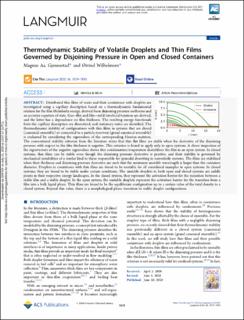| dc.contributor.author | Gjennestad, Magnus Aashammer | |
| dc.contributor.author | Wilhelmsen, Øivind | |
| dc.date.accessioned | 2020-07-31T12:20:10Z | |
| dc.date.available | 2020-07-31T12:20:10Z | |
| dc.date.created | 2020-06-04T14:01:00Z | |
| dc.date.issued | 2020 | |
| dc.identifier.citation | Langmuir. 2020, 36 (27), 7879-7893. | en_US |
| dc.identifier.issn | 0743-7463 | |
| dc.identifier.uri | https://hdl.handle.net/11250/2670577 | |
| dc.description.abstract | Distributed thin films of water and their coexistence with droplets are investigated using a capillary description based on a thermodynamic fundamental relation for the film Helmholtz energy, derived from disjoining pressure isotherms and an accurate equation of state. Gas–film and film–solid interfacial tensions are derived, and the latter has a dependence on film thickness. The resulting energy functionals from the capillary description are discretized, and stationary states are identified. The thermodynamic stability of configurations with thin films in systems that are closed (canonical ensemble) or connected to a particle reservoir (grand canonical ensemble) is evaluated by considering the eigenvalues of the corresponding Hessian matrices. The conventional stability criterion from the literature states that thin flat films are stable when the derivative of the disjoining pressure with respect to the film thickness is negative. This criterion is found to apply only in open systems. A closer inspection of the eigenvectors of the negative eigenvalues shows that condensation/evaporation destabilizes the film in an open system. In closed systems, thin films can be stable even though the disjoining pressure derivative is positive, and their stability is governed by mechanical instabilities of a similar kind to those responsible for spinodal dewetting in nonvolatile systems. The films are stabilized when their thickness and disjoining pressure derivative are such that the minimum unstable wavelength is larger than the container diameter. Droplets in coexistence with thin films are found to be unstable for all considered examples in open systems. In closed systems, they are found to be stable under certain conditions. The unstable droplets in both open and closed systems are saddle points in their respective energy landscapes. In the closed system, they represent the activation barrier for the transition between a stable film and a stable droplet. In the open system, the unstable droplets represent the activation barrier for the transition from a film into a bulk liquid phase. Thin films are found to be the equilibrium configuration up to a certain value of the total density in a closed system. Beyond this value, there is a morphological phase transition to stable droplet configurations. | en_US |
| dc.language.iso | eng | en_US |
| dc.publisher | ACS | en_US |
| dc.rights | Navngivelse 4.0 Internasjonal | * |
| dc.rights.uri | http://creativecommons.org/licenses/by/4.0/deed.no | * |
| dc.title | Thermodynamic stability of volatile droplets and thin films governed by the disjoining pressure in open and closed containers | en_US |
| dc.type | Peer reviewed | en_US |
| dc.type | Journal article | en_US |
| dc.description.version | publishedVersion | en_US |
| dc.rights.holder | ACS | en_US |
| dc.source.pagenumber | 7879-7893 | en_US |
| dc.source.volume | 36 | en_US |
| dc.source.journal | Langmuir | en_US |
| dc.source.issue | 27 | en_US |
| dc.identifier.doi | 10.1021/acs.langmuir.0c00960 | |
| dc.identifier.cristin | 1813871 | |
| dc.relation.project | Norges forskningsråd: 262644 | en_US |
| cristin.ispublished | true | |
| cristin.fulltext | original | |
| cristin.qualitycode | 2 | |

